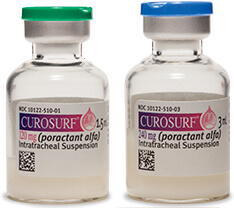Dosing, Preparing, and Administering CUROSURF
Navigate to resources and guidance for using CUROSURF in your practice.
Navigate to resources and guidance for using CUROSURF in your practice.
This comprehensive video may be used for Skills Day or training new staff on CUROSURF storage, dosing, preparation, and administration. View the entire video or choose specific chapters.
The User Guide walks through the storage, dosing, and administration procedures found in our Full Prescribing Information.

Before use, the vial should be slowly warmed to room temperature and gently turned upside down in order to obtain a uniform suspension.
Initial recommended dose = 2.5 mL/kg birth weight.
Repeat doses
Maximum recommended total dosage (sum of the initial and up to 2 repeat doses) is 5 mL/kg birth weight.
Please download User Guide for dosing instructions.
| WEIGHT (grams) | INITIAL DOSE | REPEAT DOSE | WEIGHT (grams) | INITIAL DOSE | REPEAT DOSE |
| EACH DOSE in mL (mg) | EACH DOSE in mL (mg) | ||||
| 600–650 | 1.60 (128) | 0.80 (64) | 1301–1350 | 3.30 (264) | 1.65 (132) |
| 651–700 | 1.70 (136) | 0.85 (68) | 1351–1400 | 3.50 (280) | 1.75 (140) |
| 701–750 | 1.80 (144) | 0.90 (72) | 1401–1450 | 3.60 (288) | 1.80 (144) |
| 751–800 | 2.00 (160) | 1.00 (80) | 1451–1500 | 3.70 (296) | 1.85 (148) |
| 801–850 | 2.10 (168) | 1.05 (84) | 1501–1550 | 3.80 (304) | 1.90 (152) |
| 851–900 | 2.20 (176) | 1.10 (88) | 1551–1600 | 4.00 (320) | 2.00 (160) |
| 901–950 | 2.30 (184) | 1.15 (92) | 1601–1650 | 4.10 (328) | 2.05 (164) |
| 951–1000 | 2.50 (200) | 1.25 (100) | 1651–1700 | 4.20 (336) | 2.10 (168) |
| 1001–1050 | 2.60 (208) | 1.30 (104) | 1701–1750 | 4.30 (344) | 2.15 (172) |
| 1051–1100 | 2.70 (216) | 1.35 (108) | 1751–1800 | 4.50 (360) | 2.25 (180) |
| 1101–1150 | 2.80 (224) | 1.40 (112) | 1801–1850 | 4.60 (368) | 2.30 (184) |
| 1151–1200 | 3.00 (240) | 1.50 (120) | 1851–1900 | 4.70 (376) | 2.35 (188) |
| 1201–1250 | 3.10 (248) | 1.55 (124) | 1901–1950 | 4.80 (384) | 2.40 (192) |
| 1251–1300 | 3.20 (256) | 1.60 (128) | 1951–2000 | 5.00 (400) | 2.50 (200) |
Before administration, ensure proper placement and patency of the endotracheal tube. At the discretion of the clinician, the endotracheal tube may be suctioned before administering CUROSURF. The infant should be allowed to stabilize before proceeding with dosing.
CUROSURF can be administered intratracheally by 2 different methods:
For endotracheal tube instillation using a 5 French end-hole catheter*
For endotracheal tube instillation using the secondary lumen of a dual-lumen endotracheal tube (medication administration lumen)*
*Methods are not interchangeable.
Please see accompanying Full Prescribing Information.
While these administration instructions should be followed, clinical judgment should be used for individual scenarios.
Transient adverse reactions associated with administration of CUROSURF include bradycardia, hypotension, endotracheal tube blockage, and oxygen desaturation. These events require stopping CUROSURF administration and taking appropriate measures to alleviate the condition. After the patient is stable, dosing may proceed with appropriate monitoring.
†It is important to note that the INSURE strategy may not be appropriate for all infants. Infants with RDS may vary markedly in the severity of respiratory disease, maturity, and presence of other complications, and thus it is necessary to individualize patient care.
CUROSURF® (poractant alfa) is intended for intratracheal use only. The administration of exogenous surfactants, including CUROSURF, can rapidly affect oxygenation and lung compliance. Therefore, infants receiving CUROSURF should receive frequent clinical and laboratory assessments so that oxygen and ventilatory support can be modified to respond to respiratory changes.
CUROSURF should only be administered by those trained and experienced in the care, resuscitation, and stabilization of preterm infants.
Transient adverse reactions associated with administration of CUROSURF include bradycardia, hypotension, endotracheal tube blockage, and oxygen desaturation. These events require stopping CUROSURF administration and taking appropriate measures to alleviate the condition. After the patient is stable, dosing may proceed with appropriate monitoring.
Pulmonary hemorrhage, a known complication of premature birth and very low birth-weight, has been reported with CUROSURF. The rates of common complications of prematurity observed in a multicenter single-dose study that enrolled infants 700–2000 g birth weight with RDS requiring mechanical ventilation and FiO2 ≥ 0.60 are as follows for CUROSURF 2.5 mL/kg (200 mg/kg) (n=78) and control (n=66; no surfactant) respectively: acquired pneumonia (17% vs. 21%), acquired septicemia (14% vs. 18%), bronchopulmonary dysplasia (18% vs. 22%), intracranial hemorrhage (51% vs. 64%), patent ductus arteriosus (60% vs. 48%), pneumothorax (21% vs. 36%) and pulmonary interstitial emphysema (21% vs. 38%).
CUROSURF® (poractant alfa) Intratracheal Suspension is indicated for the rescue treatment of Respiratory Distress Syndrome (RDS) in premature infants. CUROSURF reduces mortality and pneumothoraces associated with RDS.
Reference: 1. CUROSURF® (poractant alfa) Intratracheal Suspension Prescribing Information, Chiesi USA, Inc. May 2021.